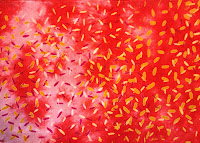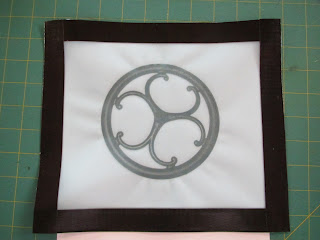In the past when I've ice dyed, I made a "parfait" of layered fabrics/shirts/scarves in a container with ice and powdered dye between each layer. That method works fine, but whatever is on the bottom gets the darkest and greatest mix of color. For a little bit more control, I've adapted another method, similar to the process I've used with snow. (For that, I've used a plastic mesh tacked to a wooden stretcher strip frame over a plastic kitty litter pan.)
I found that a mesh grapefruit bag stretches to perfectly fit an 11 x 15 inch kitty litter pan, like a sleeve.
I just stretch out the mesh bag (both ends are cut off) and slide the pan inside. Securing at opposite ends with clothespins (binder clips would work too) pulls it taught enough to hold the weight of the fabric and ice. The piece of fabric in the bottom of the pan is ready to catch the drips.
Layer your soda-ash soaked fabric or garment (about 1/2 cup soda ash per gallon of water, available from
ProChem and
Dharma Trading Co.) on top of the mesh, layer with ice cubes or crushed ice, and then sprinkle your dye powder on top. Be sure to wear rubber gloves and a protective mask when handling dye; I use MX Procion fiber reactive dyes (available from the 2 sources mentioned above, or a local art supply store such as
Artistic Artifacts in Alexandria, VA). With this method, you can still layer 2 items on top of each other, or place them side by side. I like to scrunch my fabric to get a mottled pattern. Depending on the size of the items, you might be able to do more.
The 2 photos above show a shirt and scarf placed on the pan, then the ice and dye on top. The ice should completely cover the items you are dyeing. The more ice you use, the more it will dilute the colors. For this project, I wanted, soft, mottled colors. I used yellow, coral, and turkey red. Start with your lighter colors first or they won't show up in the finished product.
Here you see the ice melting into the pan below; as it does so, the colors seep into the fabric. The ice causes some of the colors that make up the dyes to separate and form interesting patterns. When you do this process by the parfait method, whatever item is on the bottom would be sitting in all the liquid, so it will be darker and more solid than pieces on the top.
This is the t-shirt spread out a bit after the ice has melted and it continues to "batch". I let things set at least 24 hours before rinsing out. Rinse in cool water till the water runs almost clear, then hang to dry. After drying (they don't have to be completely dry), wash your items in hot water with Synthrapol (to remove excess dye). I also like to throw in a color catcher to pick up excess dye - they turn beautiful colors and are great to use in mixed media or collage projects, and are especially good for screen printing or block printing.
Here are the 3 items from this dye session hanging to dry - t-shirt, fat quarter that was in the pan to soak up the dripping dye, and a bamboo rayon scarf. I am happy with how these colors turned out - it's always a bit of a surprise, but that's the fun of it!

 Finally, a shot of one of Barbara's day lilies, and a pretty sunset - not our last night since it was a rainy day, but one of the best of camp.
Finally, a shot of one of Barbara's day lilies, and a pretty sunset - not our last night since it was a rainy day, but one of the best of camp.

 Finally, a shot of one of Barbara's day lilies, and a pretty sunset - not our last night since it was a rainy day, but one of the best of camp.
Finally, a shot of one of Barbara's day lilies, and a pretty sunset - not our last night since it was a rainy day, but one of the best of camp. 








































